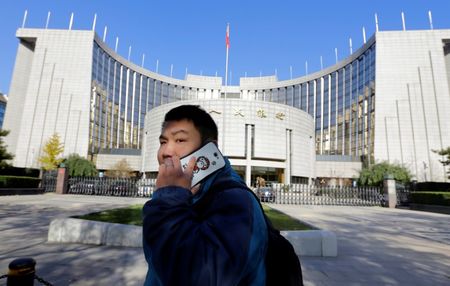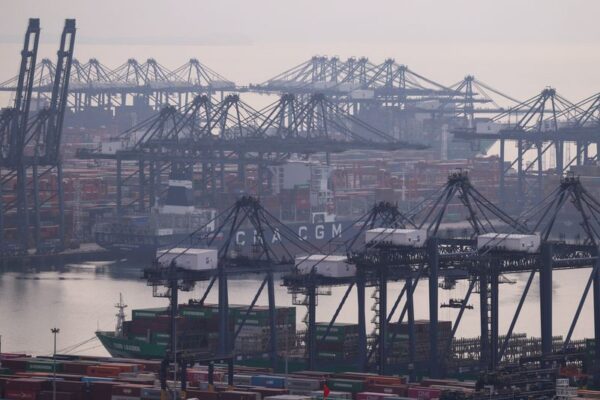China’s Central Bank Outlook Fuels Calls for Policy Easing
© Reuters. China’s Central Bank Outlook Fuels Calls for Policy Easing (Bloomberg) — China’s central bank fanned expectations of further monetary policy easing, saying in its latest quarterly report that inflation pressures are “controllable,” while highlighting risks to the economic growth outlook.
The People’s Bank of China largely reiterated its stance of stable policy, pledging to make it more forward-looking and effective, while maintaining ample liquidity. The surge in producer inflation in the first half was likely temporary, and the domestic recovery is not yet solid, it said.
The fast-spreading delta virus variant is restricting travel and spending in parts of China, prompting some economists to downgrade their growth forecasts for the world’s second-largest economy. Many of them are predicting another reduction in the reserve requirement ratio for banks after July’s surprise cut, while a few are forecasting lower interest rates as well.
China Daily cited economists in a report Tuesday saying the PBOC’s remarks could be a signal that it’s preparing to cut the RRR again or even lower policy rates. Among those quoted are Zhang Bin of the state-affiliated think tank Chinese Academy of Social Sciences.
In the quarterly report, the PBOC vowed to avoid flooding the economy with stimulus and to support it with appropriate growth in money supply.
“Overall, it points to the likelihood of additional RRR cuts in coming months, particularly since there is limited inflation pressure in China consumer prices,” said Alvin Tan, head of Asia currency strategy at RBC Capital Markets in Hong Kong.
The PBOC said inflation pressure is “controllable” because it normalized money supply since May 2020, ahead of major economies. On the other hand, the current surge of inflation in the U.S. is a result of extreme easing of monetary and fiscal policies, which made the expansion of monetary supply much faster than nominal economic growth, it said.
Some analysts said the report’s heavy focus on inflation suggests the PBOC remains cautious about excessive easing. The window for a RRR or policy rate cut may have already closed, said Ming Ming, head of fixed-income research at Citic Securities Co. Fiscal spending will likely be the mainstay of policy support in the second half, he said in a note Tuesday.
While the policy stance is unlikely to change significantly in the short term, easing will likely come when the property and export sectors show further weakness, Haitong Securities Co Ltd. economists led by Liang Zhonghua said in a note Tuesday.
Here are other key comments from the PBOC’s report:
Producer Inflation
“The surge in PPI is most likely to be temporary,” the PBOC said. “It may persist at a high level in the short term, but will probably fall back as the base effect fades and global supply production recovers.”
In the long term, the decline in labor productivity and the aging population will suppress inflation, while goals to promote green energy will push up prices. These two opposite forces will end up stabilizing overall prices, the central bank said.
Policy Stance
The PBOC reiterated it will keep monetary policy prudent and increase the autonomy of macro policies. It will decide the pace and magnitude of policy based on the domestic economy and price trends, it said.
Its surprise move to cut the reserve requirement ratio, or the amount of cash banks must park at the central bank, was a “forward-looking” action to stabilize liquidity that took into consideration factors including tax payment season, maturing policy loans and faster local government bond issuance, the PBOC said.
Domestic Economy
“The basis of the domestic recovery is not yet solid, and export growth may slow due to the effect of a higher base,” the central bank said. “Investment growth in some areas is relatively weak, and consumer industries like catering and tourism have not yet fully recovered. The sustainability of the economy’s growth momentum may face challenges.”
The PBOC also said small businesses are particularly hard hit due to surging commodity prices, and noted there’s pressure on bad assets and shadow banking to rebound.
Structural Tools
To address regional imbalance in development, the PBOC allocated a special re-lending quota of 200 billion yuan ($30.9 billion) to purchase bank loans in regions with slower credit growth. It purchased 160 billion yuan worth of loans by the end of June.
This helps explain the ample liquidity in the first half and an unusual increase in a gauge measuring cash injections in May, according to Zhong Linnan, a macro analyst at GF Securities Co Ltd.
More structural policy tools, such as re-lending funds or medium-term financing facility loans with lower interest rates, are likely to be rolled out soon to support selected regions, small businesses and green projects, said Citic Securities’ Ming.
(Updates with additional comments, section on structural policies)
©2021 Bloomberg L.P.












 Bitcoin
Bitcoin  Ethereum
Ethereum  Tether
Tether  XRP
XRP  USDC
USDC  Solana
Solana  TRON
TRON  Lido Staked Ether
Lido Staked Ether  Dogecoin
Dogecoin